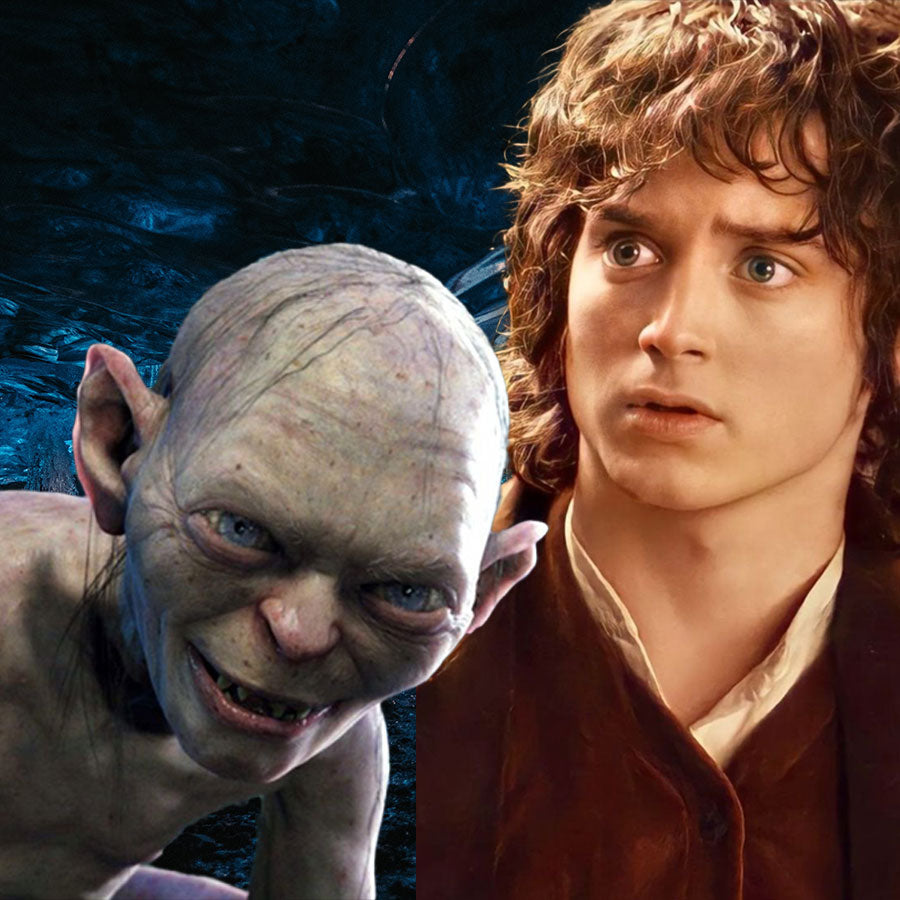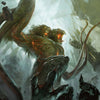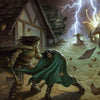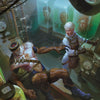Using Rivals and Foils in D&D

Two awesome storytelling mechanics that you see used ALL THE TIME in literature and movies – but that folks often overlook in their tabletop roleplaying games – are Rivals and Foils. These are two advanced game master techniques you can use in your tabletop roleplaying game.
This article will have three parts: First, we’ll discuss the difference between a rival and a villain. Then, we’ll deep dive into what rivals and foils actually are. And finally, we’ll talk about how to use rivals and foils in your games.
By the way, if you’re a new dungeon master feeling a bit OVERWHELMED by everything involved in running a D&D game, I completely understand. Being a DM isn’t always easy, and my personal goal is to help game masters by providing information and resources to make your life easier! That’s why my team and I make all these articles and videos.
However, Lairs & Legends is another such resource. With over 700 pages of adventures, monsters, puzzles, traps, and other 5e GM resources, you can SIGNIFICANTLY reduce your prep time and still run amazing games for your players.
Watch or listen to this article by clicking the video below.
Part 1: Rival vs. Villain
Now, rivals and villains are both antagonists – those are the bad guys – but they each serve the narrative in different way. In general, antagonists exist in a game such as D&D to provide a challenge or test for your players and their characters.
Villains are the ultimate test for the characters, someone who needs to be stopped for some greater purpose, and they are usually morally opposed to the characters. Villains tend to be overcome and defeated in some permanent way. Villains usually start at or near the power level that they will be when the characters finally confront them in some climatic challenge.
The Big Bad and his various lieutenants in the game world are the most obvious examples of villains in typical RPG.
Rivals, on the other hand, are meant to motivate or hinder characters, and challenge them on their own level. While rivals and the characters are often at odds, neither really sees the other as a villain. In fact, they may even possess the same moral values.
Rivals are meant to recur and vex the characters throughout their story, and thus they serve the long-term narrative in a game. On an interesting note, it may be easier for players to understand and relate to the idea of rivalry rather than true villainy in the real world.
A rival adventuring group that is competing for the king’s favor, delving into some of the same dungeons, or searching for the same McGuffin that the players’ characters are looking for is a classic example of a rival in a typical tabletop RPG such as D&D or Pathfinder.
Part 2: Rival and Foil Deep Dive
Rivals and Foils go hand in hand.
- A rival OPPOSES something essential in the player character. As we discussed, they get in the way and inhibit the characters in some way.
- A foil EXPOSES something essential about the player character. Foils exist to hold mirrors up to the characters and show them something about themselves.
Note that not every rival is a foil, and not every foil is a rival. However, the best rivals are also foils.
Defining Rivals and Foils
One purpose of rivals is to motivate the characters: give them something to aspire to, serve as a cautionary tale, or something to avoid becoming. And as we examine rivals, we’ll find that they generally fall into three different categories.
The Competition: These rivals are in direct competition with the characters in some way. This type of rival might show up in things like "tournament arcs," but it can also be used across an entire campaign, such as a rival adventuring party that gets involved with some of the characters' adventures and seeks the same rewards.
The Challenger: This is less common than the competition, and these rivals exist to actively challenge the characters with the intent of making them better. These rivals are normally sent by some other agent to challenge the characters, but they can also be individuals that have their own reasons for doing so. In worlds where time travel is available, these could even be rivals from the future who need the heroes to be ready for some future challenge.
The Enigma: This is another less common type of rival. The enigma gets in the way of the characters or opposes them for unknown reasons. They appear seemingly out of nowhere at unexpected times and make adventures harder or more complicated. Eventually, enigma's are revealed to be something else, usually Competition or a Challenger, but they can even turn out to be unexpected allies or ancillary villains.
An important thing to remember is that rivals are not villains, even though they often block or impede the characters from achieving their goals in some way. However, despite that fact, I think what you’ll find is that the relationships that rivals build with the characters can help propel the story forward.
An example of rivals from the Lord of the Rings is Boromir and Aragorn. They both mostly want the same thing: the defeat of Saruman and the safety of Gondor. However, they have different thoughts on how the Ring of Power should be used: Boromir would use the Power against Saruman, whereas Aragorn knows that the Ring cannot be trusted and must be destroyed. So, while both of them share the same high-level goal, they clash and compete with each other as rivals insomuch as what is to be done with the One Ring.
Okay, now let’s deep dive on foils.
Foils exist to show or teach the characters something about themselves. For instance, they help the players better understand their own characters' bonds and flaws or provide opportunities for character growth outside of game mechanics. Furthermore, they can help show the characters what they might have become if they had chosen a different path.
Foils can generally be categorized into two types: opposites and reflections.
Opposites are the easier type of foil to recognize and create. They're everything that the character isn't. Picture the classic paladin that seeks to promote law and goodness vs. the stereotypical selfish rogue who believes in freedom and flexibility outside of the law.
If we turn again to the Lord of the Rings, Frodo and Gollum are great examples of opposite foils. Both characters are ring-bearers, and where Gollum has been mostly corrupted by the Ring’s influence, Frodo has just started down that road. As a foil Gollum, who is consumed by greed, serves as a constant reminder of what might happen to Frodo. However, as Gollum’s opposite, Frodo often displays compassion and pity, especially towards Gollum. From a storytelling point of view, this foil relationship between the two underscores the theme of choice and the possibility of redemption in the narrative.
Reflections are harder to recognize and perhaps more complex. However, they can be a more powerful type of foil than opposites. An NPC that is a reflection of a character is very similar to the character, but with one point of contention. For example, you could have two fighters that are paragons of virtue, but one was raised poor and dreamed of being a member of the nobility, while the other was born noble and dreamed of being free to live their lives however they would want. Being pitted together as rivals allows each to realize that the things they value or dream about may not be as great as they think.
Remember that the best rivals are also foils, serving to highlight and contrast the characters to bring out their attributes. However, whereas rivals serve to propel the narrative forward, foils exist to propel the characters forward through personality growth and development.
As a final note on foils, I’d like to point out that foils don't HAVE to be antagonists. When we look at Draco Malfoy and Harry Potter or Gollum or Frodo Baggins, we see foils that are also antagonists. However, if we cast our gaze toward Dr. John Watson and Sherlock Holmes, we will find a foil that is NOT an antagonist. Dr. Watson and Holmes worked together; they were partners. Upon examination, we will see that their OUTLOOKS are what made Watson a foil for Homles. Whereas Holmes is neurotic, selfish, and insensitive, Watson is empathetic, selfless, and ordered. This juxtaposition drives Holmes to become better because of their friendship.
Part 3: Using Rivals and Foils in Your Game
Okay, now let’s talk about how to use rivals and foils in your games. And as a note, to avoid saying “rivals and foils” a million times, I’m just going to say rivals, and it will be understood that I’m talking about both.
First, they should be created as a team of comparable size and ability to the characters. In literature, a single rival is generally pitted against a single protagonist, but in RPGs there is rarely a single protagonist, but instead a team of characters working together. Therefore, the rivals should be comparable to the characters.
Rivals should begin the campaign in opposition to the characters, but NOT as enemies. Of course, depending on how the campaign unfolds, they might evolve into enemies or allies.
Next, rivals and foils should never only exist as rivals or foils. They should clearly have their own motivations and goals that just happen to put them in the position of rival or foil. Of course, you and I know that the game master did it intentionally, but remember that it’s all smoke and mirrors anyway.
Rivals work best when introduced early in a campaign so that they can grow and evolve with the characters. And then you have them appear occasionally to vex and impede the characters. I would caution against using them too frequently, otherwise they might become overdone.
Next, make sure you’re keeping track of where the rivals are and what they're doing in the world when they're not directly interacting with the characters' story. Keep track of the rivals' attitudes toward the PCs and adjust them as the game progresses. Positive interactions or friendly competition can eventually turn rivals into allies, while continual hostility can turn them into full-fledged villains.
Be careful not to over-plan the rivals’ evolution or roles in the greater campaign. Much like the players’ characters, the rivals’ growth and evolution as NPCs should occur based on their interactions with the PCs and the world.
Also, from time to time turn things on their heads: The rivals might begrudgingly ask for the heroes' aid, or the heroes may need a rival's specialization to complete a task.
Rivals can and should interact with the characters and get involved in all three pillars of the game. This doesn't mean that the characters and rivals must always or even ever fight each other, though it could, but perhaps that the rivals complicate the heroes’ fight, get in the way of combat, steal the characters’ victory, or fight alongside them.
If things come to blows -- unless the rivals have devolved into real villains -- they should never kill PCs if they win in combat. Instead, they should choose to stabilize them and leave them to recover, perhaps with some added touches to add to the characters' humiliation or the rivals' amusement.
Furthermore, as the party makeup changes, the rivals can change as well. If a PC dies or leaves the campaign, their rival can leave and be replaced with a new rival that better fits the new character, or perhaps an old rival evolves in a way that makes them more of a rival for the new character.
Remember to avoid railroading. For instance, the GM shouldn’t force things so that the rivals always come out on top, nor should they arrange for the PCs to always come out on top.
Regardless of how the characters and their rivals get along, interaction with the rivals should be FUN for the PLAYERS.
Finally, don't overuse rivals and foils, or they will lose their impact and power.
Being a Dungeon Master Shouldn’t Be an Exercise in Frustration!
When I was a new dungeon master, I was overwhelmed with everything I needed to do. Learn the rules, create the adventures, run the game, handle problem players—it was A LOT! And even as a veteran DM, it’s still a lot. You might even feel that way yourself.
This is exactly why my team and I dedicate our time to producing resources to help our fellow dungeon masters: we know exactly how you sometimes feel!
Now, if you’re stressed out with having to create all the adventures for your 5e game, or you’re looking for elements such as traps, puzzles, and encounters that you can drag and drop into your game, we have you covered. With Lairs & Legends and Loot & Lore, you’ll get over 700 pages of 5e resources:
- Twenty-nine 5e adventures spanning levels 1 to 15 and designed for groups of 4 to 6 players.
- Over 100 new creatures from CR 0 to CR 24.
- Adventure Ideas
- Encounters with Full-Color and Blackline Digital Maps
- Patrons & Factions
- Magic Items
- NPCs
- Puzzles
- Random Encounter Tables
- Random Tables
- Spells
- Subclasses
- Traps
- Villains
Everything is designed to be EASY TO USE and QUICK TO PREP for your game. Our goal is to make game masters’ lives easier, not more complex!
Don’t spend another moment frustrated and overwhelmed as a DM. Pick up the Lairs & Legends Ultimate Bundle today and find out how much easier being a DM can be!
-
Posted in
Game Master How-To Articles







